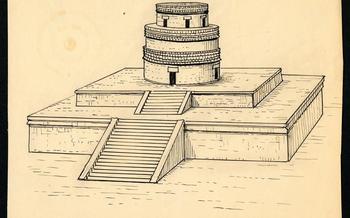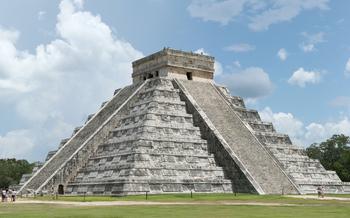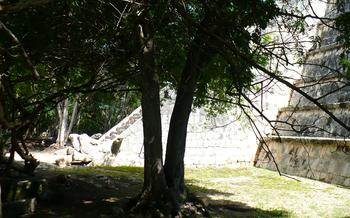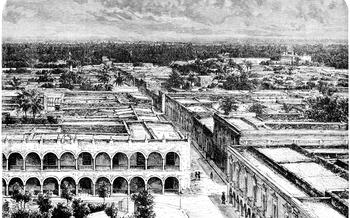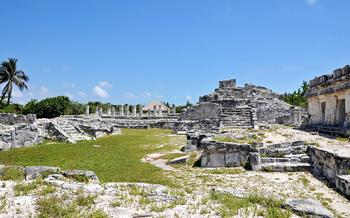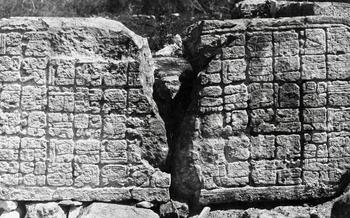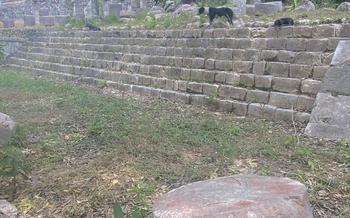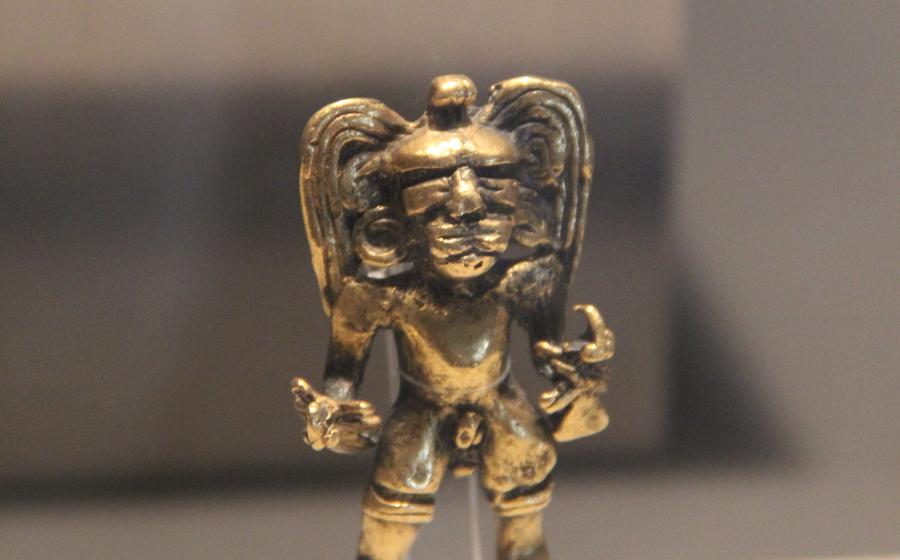
The Sacred Cenote
- Chichén Itzá: An Enigmatic Legacy
- Unveiling the Sacred Cenote
- Maya Cosmology and the Cenote
- Archaeological Mysteries
- The Cenote's Ritualistic Significance
- The Cenote's Natural Beauty
- Safety and Access
- Chichén Itzá's Other Wonders
- Local Tours and Guides
- Planning Your Visit
- Responsible Tourism: Preserving the Legacy for Future Generations
- Photography Tips: Capturing the Essence of Chichén Itzá and the Cenote
- The Cenote's Spiritual Significance
- Chichén Itzá's Nighttime Magic
- Insider Tip: Exploring the Cenote's Underground Caves
Chichén Itzá: An Enigmatic Legacy
In the heart of Mexico's Yucatán Peninsula, lies the enigmatic city of Chichén Itzá, a testament to the grandeur of Maya civilization. Its iconic structures, including the majestic El Castillo pyramid, stand as silent guardians of a rich history, inviting visitors to unravel the secrets of a civilization that flourished centuries ago.
Chichén Itzá's legacy extends beyond its physical remains. It was a vibrant center of political, cultural, and religious significance, leaving an enduring mark on post-Classical Mesoamerica. As the capital of the Maya-Toltec alliance, it blended the traditions of two great civilizations, creating a unique cultural tapestry.
The city's strategic location facilitated trade and interaction with other Mesoamerican regions, enabling the exchange of ideas, technologies, and cultural practices. Chichén Itzá's influence radiated far and wide, shaping the political and cultural landscape of the region.
Beyond its political and economic prowess, Chichén Itzá held profound religious and spiritual importance. It was a sacred site, home to numerous temples, altars, and cenotes, each serving a specific purpose in the Maya worldview. The city's intricate calendar systems, astronomical observations, and rituals reflected their deep connection to the cosmos and their belief in the interconnectedness of all living things.
Unveiling the Sacred Cenote
The Sacred Cenote, a natural sinkhole imbued with profound spiritual significance, lies at the heart of the ancient city of Chichén Itzá. This enigmatic body of water, approximately 60 meters in diameter and 20 meters deep, is an awe-inspiring testament to the Maya civilization's intricate cosmology and religious practices.
The cenote's crystal-clear waters, framed by towering limestone cliffs and lush vegetation, create a breathtaking spectacle. It served as a vital water source for the Maya people and played a central role in their religious ceremonies and rituals.
According to Maya beliefs, the cenote was a portal to the underworld, Xibalba, where the gods resided. It was considered a sacred place where offerings were made to deities, including jade, gold, and even human sacrifices. These offerings were believed to ensure the continuity of life and the well-being of the Maya people.
The cenote's association with rain gods and fertility further highlights its importance in Maya culture. The Maya believed that by throwing offerings into the cenote, they could appease the gods and ensure bountiful harvests and rainfall.
The Sacred Cenote stands as a powerful reminder of the Maya civilization's deep connection to the natural world and their intricate spiritual beliefs. It invites visitors to delve into the mysteries of a lost civilization and marvel at the enduring legacy of the Maya people.
Maya Cosmology and the Cenote
The Maya believed that the cenote was a sacred portal, a bridge between the realms of the living and the dead. They saw it as a gateway to Xibalba, the Maya underworld, a place of darkness and danger but also of regeneration and rebirth. The cenote was considered a place where the gods could be directly accessed, and where the Maya could communicate with their ancestors and seek their guidance and protection.
The cenote was also associated with the rain gods and fertility. The Maya believed that by performing rituals and offerings at the cenote, they could influence the weather and ensure good harvests. They believed that the cenote was a source of life-giving water, essential for the survival and prosperity of their civilization.
The cenote's connection to the Maya afterlife is further evidenced by the discovery of human remains and artifacts within its depths. These remains suggest that the cenote was used for burials and other rituals related to the afterlife. The Maya believed that the souls of the dead traveled to Xibalba through the cenote, where they would be judged and either rewarded or punished for their actions in life.
Archaeological Mysteries
The Sacred Cenote has been a subject of extensive archaeological research, revealing a wealth of artifacts and human remains, providing valuable insights into Maya rituals and offerings. Archaeologists have discovered jade, gold ornaments, ceramics, and even human bones, indicating the cenote's significance as a sacrificial site. Ongoing excavations continue to unveil the secrets of Maya rituals and ceremonies, providing a deeper understanding of their complex culture. However, deciphering the symbolism and significance of the cenote remains a challenge, as many aspects of Maya cosmology and beliefs are still shrouded in mystery.
The Cenote's Ritualistic Significance
The Sacred Cenote served as a focal point for religious ceremonies and rituals, deeply embedded in the Maya worldview. Maya priests and rulers performed elaborate rituals, offering precious jade, gold, and even human sacrifices to appease the gods and ensure their favor. These offerings were believed to be a form of communication with the divine, a way to express gratitude, seek guidance, or request protection.
The cenote's significance extended beyond individual devotion; it was a place of collective pilgrimage and communal ceremonies. Maya from across the region would gather to participate in festivals, rituals, and celebrations that honored the gods and celebrated the cycles of life and nature. Through these rituals, the Maya reinforced their spiritual connection to the cenote, the underworld, and the divine forces that governed their world.
The cenote's role as a sacred site is further reflected in its symbolic representation of the Maya worldview and cosmology. The cenote was seen as a portal, a bridge between the realms of the living and the dead. It was believed that the cenote's waters led to Xibalba, the Maya underworld, where the souls of the deceased journeyed after death. This connection to the afterlife made the cenote a place of both reverence and fear, a place where the living could commune with the spirits of their ancestors and seek guidance from the gods.
The Cenote's Natural Beauty
The Sacred Cenote is not only a site of historical and cultural significance but also a breathtaking natural wonder. The crystal-clear waters, ranging from deep blue to vibrant turquoise, create a mesmerizing spectacle. The cenote's depth allows for captivating underwater exploration, revealing a diverse array of aquatic life.
The surrounding limestone cliffs, adorned with lush vegetation, provide a picturesque backdrop. The lush greenery contrasts beautifully with the cenote's vibrant waters, creating a harmonious blend of nature's elements. The cenote's unique ecosystem supports a variety of flora and fauna, including colorful fish, exotic birds, and diverse plant life.
Whether you choose to swim, snorkel, or simply relax on the cenote's edge, the natural beauty of this sacred site will leave you in awe. It's a place where history, culture, and nature converge, offering a truly unforgettable experience for visitors from around the world.
Safety and Access
A visit to the Sacred Cenote is a blend of cultural immersion and natural exploration. Safety measures are paramount to ensure a responsible and fulfilling experience. Designated paths and platforms guide visitors to the cenote's edge, allowing for safe access and unobstructed views. For those seeking a closer encounter, swimming and snorkeling are permitted. Life jackets are provided, and swimming is restricted to designated areas. To preserve the cenote's delicate ecosystem, touching and disturbing the rock formations are discouraged. Local experts and tour guides are readily available to provide insights, safety guidance, and a deeper understanding of the cenote's cultural significance.
Chichén Itzá's Other Wonders
Beyond the Sacred Cenote, Chichén Itzá boasts an array of captivating attractions that showcase the ingenuity and grandeur of the Maya civilization. Explore the iconic El Castillo, also known as the Temple of Kukulcan, a majestic pyramid that dominates the site's skyline. Climb its steep steps to reach the summit and marvel at the breathtaking views of the surrounding landscape. Discover the Great Ball Court, one of the largest and best-preserved ball courts in the Maya world, and learn about the ritualistic significance of this ancient sport.
Unveil the Temple of Kukulcan, adorned with intricate carvings depicting feathered serpents and other mythological figures. Listen to the unique acoustics of this structure, where claps or whistles produce a haunting echo that resonates through the surrounding plazas. Immerse yourself in the mysteries of Chichén Itzá's lesser-known temples, such as the Temple of the Warriors, the Temple of the Jaguars, and the Temple of the Skulls, each offering a glimpse into the diverse architectural styles and religious practices of the Maya.
Local Tours and Guides
Venturing into Chichén Itzá and the Sacred Cenote with a knowledgeable local guide can transform your experience from a casual visit to a journey of profound understanding. These guides are custodians of Maya history and culture, eager to share their insights and passion with visitors.
Local guides offer customized tours tailored to your interests and time constraints. Whether you're fascinated by the architectural marvels, the intricate symbolism, or the spiritual significance of the site, your guide will craft an itinerary that caters to your specific needs.
Through their narratives, you'll gain a deeper appreciation for the Maya civilization, their sophisticated calendar system, and their unique worldview. They'll unravel the mysteries of the cenote, explaining its role in Maya rituals, mythology, and cosmology.
Hiring a local guide not only enriches your experience but also supports the local community. These guides are often descendants of the Maya people, and their work helps preserve and promote their cultural heritage. By choosing a local guide, you're contributing to the sustainability of this extraordinary site.
Planning Your Visit
To fully appreciate the wonders of Chichén Itzá and the Sacred Cenote, planning your visit is crucial. The best time to visit is during the shoulder seasons (April-May and September-October) when the weather is pleasant, and the crowds are smaller. This allows for a more intimate and immersive experience.
When packing for your trip, remember to bring swimwear, towels, and sun protection, as the cenote is a popular spot for swimming and snorkeling. Comfortable shoes are also recommended for exploring the extensive ruins of Chichén Itzá.
Booking tickets and arranging transportation in advance is advisable to avoid any last-minute surprises. Several tour operators offer guided tours to Chichén Itzá, which can provide valuable insights into the history and significance of the site.
Remember, while visiting Chichén Itzá and the Sacred Cenote, respect local customs and traditions. Ask for permission before taking photographs of local people, and be mindful of the sacred nature of the site.
Responsible Tourism: Preserving the Legacy for Future Generations
As responsible travelers, it is our duty to protect the delicate ecosystem of the Sacred Cenote and ensure its preservation for generations to come. Here are some guidelines to follow:
-
Minimize Environmental Impact: Avoid using harsh chemicals or sunscreens that can pollute the cenote's waters. Opt for eco-friendly alternatives to protect its natural beauty.
-
Respect Local Customs: Dress appropriately when visiting the cenote, respecting the cultural and religious significance of the site. Refrain from loud noises or disruptive behavior to maintain a peaceful atmosphere.
-
Support Local Communities: Choose local tour operators and guides who are committed to sustainable tourism practices. This not only supports the local economy but also ensures that the cenote is managed responsibly.
-
Leave No Trace: Always dispose of waste properly in designated bins. Avoid leaving behind any personal belongings or trash, ensuring the cenote remains pristine for all visitors.
By embracing responsible tourism practices, we can help preserve the Sacred Cenote's natural and cultural heritage while ensuring a sustainable and fulfilling experience for all.
Photography Tips: Capturing the Essence of Chichén Itzá and the Cenote
The Sacred Cenote and Chichén Itzá offer a treasure trove of photographic opportunities. To capture their beauty and essence, consider the following tips:
-
Harness Natural Lighting: Utilize the golden hours of sunrise and sunset for the most vibrant colors and dramatic shadows. The soft, diffused light during these times enhances the natural beauty of the cenote's waters and the architectural details of Chichén Itzá.
-
Experiment with Angles and Perspectives: Don't just shoot from eye level. Try different angles and perspectives to create unique and captivating compositions. Climb the surrounding platforms or find vantage points to capture breathtaking aerial shots of the cenote and the surrounding ruins.
-
Embrace the Reflections: The cenote's crystal-clear waters offer stunning reflections of the surrounding structures. Use this to your advantage by positioning yourself at strategic angles to capture the mirrored beauty of the cenote and the ancient ruins.
-
Understand Photography Permits: Be aware of photography regulations and permits required at Chichén Itzá. Some areas may have restrictions or require special permits for photography, especially for commercial purposes. Research and obtain the necessary permits before your visit to avoid any hassles.
The Cenote's Spiritual Significance
Beyond its historical and archaeological significance, the Sacred Cenote holds deep spiritual meaning for the Maya people. It was considered a portal to the underworld, a place where the living could communicate with the dead and seek guidance from their ancestors. The cenote's waters were believed to possess healing properties, and it was customary for pilgrims to bathe in the cenote to cleanse themselves both physically and spiritually.
Even today, the cenote retains its spiritual significance. Maya rituals and ceremonies are still performed at the cenote, and many visitors come to the site to meditate and connect with the spiritual energy of the place. There is a sense of peace and tranquility at the cenote, making it an ideal place for reflection and introspection.
Some people believe that the cenote is a vortex of energy, a place where the veil between the worlds is thin. They claim to have experienced visions and spiritual awakenings while swimming in the cenote's waters. Whether or not one believes in the spiritual power of the cenote, there is no denying its profound impact on the Maya people and the enduring legacy of their beliefs.
Chichén Itzá's Nighttime Magic
As the sun sets and darkness envelops the ancient city, Chichén Itzá transforms into a mystical realm. The night sky glitters with stars, casting an ethereal glow upon the towering pyramids and temples. This is the time when the true magic of Chichén Itzá unfolds.
One of the most captivating experiences is the mesmerizing light and sound show projected onto El Castillo, the iconic pyramid. The show narrates the history and legends of the Maya civilization through vibrant colors, dramatic music, and captivating storytelling. As the pyramid comes alive with ancient tales, you'll feel transported back in time, witnessing the grandeur of Chichén Itzá's past.
Exploring the cenote at night is another enchanting experience. The darkness adds an air of mystery and intrigue as you descend into the depths of the sacred well. The cenote's crystal-clear waters shimmer under the moonlight, revealing the hidden caves and crevices that lie beneath the surface.
With fewer crowds and a serene atmosphere, nighttime is the perfect time to connect with the spiritual essence of Chichén Itzá. Whether you're meditating under the stars, seeking energy vortexes, or simply marveling at the beauty of the site, the night offers a unique and unforgettable experience.
Insider Tip: Exploring the Cenote's Underground Caves
For an unforgettable and thrilling experience, venture into the hidden depths of the Sacred Cenote by exploring its underground caves. These caves offer a unique glimpse into the mysterious world beneath the cenote's surface. Hire a local guide who can lead you safely through the caves and share their knowledge of the site's history and significance. Remember to bring appropriate safety equipment, including helmets, flashlights, and comfortable shoes, as the caves can be slippery and dark. The reward for your efforts will be breathtaking views of subterranean chambers, ancient rock formations, and the chance to discover hidden secrets that few visitors ever see. Immerse yourself in the cenote's mystical aura and create lasting memories that will stay with you long after your visit.
